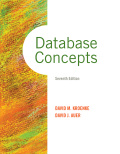
EBK DATABASE CONCEPTS
7th Edition
ISBN: 9780133544886
Author: AUER
Publisher: PEARSON CUSTOM PUB.(CONSIGNMENT)
expand_more
expand_more
format_list_bulleted
Concept explainers
Expert Solution & Answer
Chapter 5, Problem 5.2RQ
Explanation of Solution
Attribute:
In
- Generally columns in the table are called as an attributes.
Steps for transforming attributes into columns:
- Initially create a table for each entity.
- Each attributes in an entity must have a column in the corresponding table.
- Specify one column as the primary key for that table.
Column properties:
While transforming attributes into columns, it should specify some column properties. They are:
- Null status
- Data type
- Specify data constraints
- Default value
Example:
Consider the example of transforming attributes into columns is as follows:
Attribute:
Expert Solution & Answer
Want to see the full answer?
Check out a sample textbook solution
Students have asked these similar questions
Show the work
show all the work
show all the work
Chapter 5 Solutions
EBK DATABASE CONCEPTS
Ch. 5 - Explain how entities are transformed into tables.Ch. 5 - Prob. 5.2RQCh. 5 - Prob. 5.3RQCh. 5 - What is denormalization?Ch. 5 - Prob. 5.5RQCh. 5 - Explain the problems that denormalized tables may...Ch. 5 - Explain how the representation of weak entities...Ch. 5 - Explain how supertype and subtype entities are...Ch. 5 - Prob. 5.9RQCh. 5 - Prob. 5.10RQ
Ch. 5 - Show two different ways to represent the 1:1...Ch. 5 - Prob. 5.12RQCh. 5 - Prob. 5.13RQCh. 5 - Prob. 5.14RQCh. 5 - Prob. 5.15RQCh. 5 - Prob. 5.16RQCh. 5 - For your answer to question 5.15, code an SQL...Ch. 5 - Prob. 5.18RQCh. 5 - Prob. 5.20RQCh. 5 - Prob. 5.21RQCh. 5 - Explain how the terms parent table and child table...Ch. 5 - For your answers to questions 5.20, 5.21, and...Ch. 5 - Prob. 5.24RQCh. 5 - Prob. 5.25RQCh. 5 - Prob. 5.26RQCh. 5 - Prob. 5.27RQCh. 5 - Prob. 5.28RQCh. 5 - Define the three types of recursive binary...Ch. 5 - Prob. 5.30RQCh. 5 - Prob. 5.31RQCh. 5 - Prob. 5.32RQCh. 5 - Prob. 5.33RQCh. 5 - Prob. 5.34RQCh. 5 - Code an SQL statement that creates a table with...
Knowledge Booster
Learn more about
Need a deep-dive on the concept behind this application? Look no further. Learn more about this topic, computer-engineering and related others by exploring similar questions and additional content below.Similar questions
- List down the strenghts and weaknesses of your team project for Capsim Simulation? Explan.arrow_forwardCapsim Team PowerPoint Presentations - Slide Title: Key LearningsWhat were the key learnings that you discovered as a team through your Capsim simulation?arrow_forwardWrite the SQL code that permits to implement the tables: Student and Transcript. NB: Add the constraints on the attributes – keys and other.arrow_forward
- Draw an ERD that will involve the entity types: Professor, Student, Department and Course. Be sure to add relationship types, key attributes, attributes and multiplicity on the ERD.arrow_forwardDraw an ERD that represents a book in a library system. Be sure to add relationship types, key attributes, attributes and multiplicity on the ERD.arrow_forward2:21 m Ο 21% AlmaNet WE ARE HIRING Experienced Freshers Salesforce Platform Developer APPLY NOW SEND YOUR CV: Email: hr.almanet@gmail.com Contact: +91 6264643660 Visit: www.almanet.in Locations: India, USA, UK, Vietnam (Remote & Hybrid Options Available)arrow_forward
- Provide a detailed explanation of the architecture on the diagramarrow_forwardhello please explain the architecture in the diagram below. thanks youarrow_forwardComplete the JavaScript function addPixels () to calculate the sum of pixelAmount and the given element's cssProperty value, and return the new "px" value. Ex: If helloElem's width is 150px, then calling addPixels (hello Elem, "width", 50) should return 150px + 50px = "200px". SHOW EXPECTED HTML JavaScript 1 function addPixels (element, cssProperty, pixelAmount) { 2 3 /* Your solution goes here *1 4 } 5 6 const helloElem = document.querySelector("# helloMessage"); 7 const newVal = addPixels (helloElem, "width", 50); 8 helloElem.style.setProperty("width", newVal); [arrow_forward
- Solve in MATLABarrow_forwardHello please look at the attached picture. I need an detailed explanation of the architecturearrow_forwardInformation Security Risk and Vulnerability Assessment 1- Which TCP/IP protocol is used to convert the IP address to the Mac address? Explain 2-What popular switch feature allows you to create communication boundaries between systems connected to the switch3- what types of vulnerability directly related to the programmer of the software?4- Who ensures the entity implements appropriate security controls to protect an asset? Please do not use AI and add refrencearrow_forward
arrow_back_ios
SEE MORE QUESTIONS
arrow_forward_ios
Recommended textbooks for you
 Np Ms Office 365/Excel 2016 I NtermedComputer ScienceISBN:9781337508841Author:CareyPublisher:Cengage
Np Ms Office 365/Excel 2016 I NtermedComputer ScienceISBN:9781337508841Author:CareyPublisher:Cengage A Guide to SQLComputer ScienceISBN:9781111527273Author:Philip J. PrattPublisher:Course Technology PtrCOMPREHENSIVE MICROSOFT OFFICE 365 EXCEComputer ScienceISBN:9780357392676Author:FREUND, StevenPublisher:CENGAGE L
A Guide to SQLComputer ScienceISBN:9781111527273Author:Philip J. PrattPublisher:Course Technology PtrCOMPREHENSIVE MICROSOFT OFFICE 365 EXCEComputer ScienceISBN:9780357392676Author:FREUND, StevenPublisher:CENGAGE L Principles of Information Systems (MindTap Course...Computer ScienceISBN:9781305971776Author:Ralph Stair, George ReynoldsPublisher:Cengage Learning
Principles of Information Systems (MindTap Course...Computer ScienceISBN:9781305971776Author:Ralph Stair, George ReynoldsPublisher:Cengage Learning



Np Ms Office 365/Excel 2016 I Ntermed
Computer Science
ISBN:9781337508841
Author:Carey
Publisher:Cengage

A Guide to SQL
Computer Science
ISBN:9781111527273
Author:Philip J. Pratt
Publisher:Course Technology Ptr

COMPREHENSIVE MICROSOFT OFFICE 365 EXCE
Computer Science
ISBN:9780357392676
Author:FREUND, Steven
Publisher:CENGAGE L

Principles of Information Systems (MindTap Course...
Computer Science
ISBN:9781305971776
Author:Ralph Stair, George Reynolds
Publisher:Cengage Learning